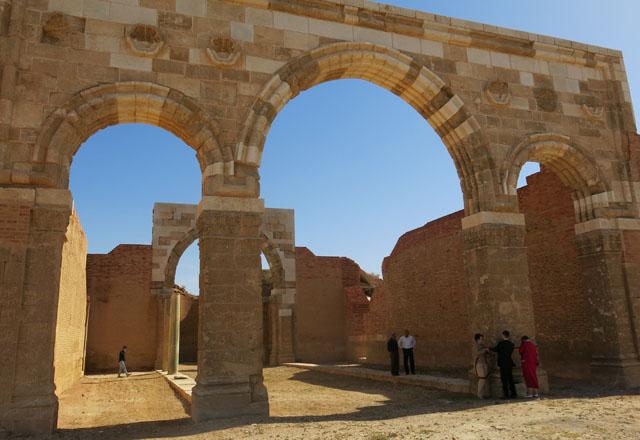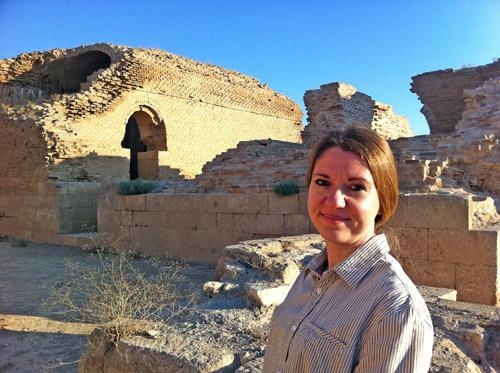You are here
Conservationists unveil restored Qasr Mushatta
By Elisa Oddone - May 18,2014 - Last updated at May 18,2014

AMMAN — Jordanian and German conservationists on Sunday unveiled the final restoration of an eighth-century fortress dating back to the Umayyad era, a building they see as a bridge between Eastern and Western art, which led to a new Islamic style.
Qasr Mushatta, located 30 kilometres south of Amman, is one of the Kingdom’s desert castles, and one of a few architectural examples with decorative elements borrowing from the Greco-Roman, Coptic and Persian cultures, conservationists said at the site’s opening ceremony.
HRH Prince Hassan inaugurated the revamped site, saying that the protection of cultural heritage was a vital part of the protection of people in times of crisis.
"Cultural heritage provides citizens with invaluable resources to build communities and to restore broken cultural ties; we must not let the uncertainty and unrest deprive current and future generations of their identity," the prince said.
A gift from Ottoman Sultan Abdul Hamid II to Kaiser Wilhelm II, the last German emperor, in 1903, parts of the palace's decorated southern facade are on display in Berlin’s Pergamon Museum as a key example of early Islamic art with forms of arabesque and animals carved in relief.
"The first step in the restoration was stabilising the palace’s vaults and walls," Barbara Perlich, architect and buildings archaeologist from Berlin’s Technical University (TU), told The Jordan Times.
"Then, we started with the brick work. Restoration teams used about 1.5 million bricks of the same material used millennia ago to reconstruct the palace’s surrounding walls," Perlich said, adding that it took six months to eventually find the right material.
Conservationists also restored the castle’s internal three-arch facade to its former glory.
Occasional visitors and vandals have been chipping away stones belonging to the palace’s facade over the years, leading the conservationists to the decision to put the stones back in place.
"This was not our first idea since, as a ruin, it should be left as it is and since it was never completely finished, it should also be left as such. But it was the best way to preserve the arches," said Perlich, who has been working on the site since 2009.
Conservationists thought the facade’s arches to be round, only to later discover original drawings from the Umayyad era on its remaining walls showing pointed arches.
Archaeologists also used computer programmes to verify the shape of the original arches in relation to the numbers and forms of the facade’s stones left on the site.
"The restoration work came along with research about the site. The three-arch facade would not have looked like this if we had not thoroughly conducted the research," Perlich said.
The Germany Research Foundation financed, the JD1.5 million research on the site, with the cost of the five-year restoration amounting to JD600,000.
German State Secretary of the Federal Foreign Office Stephan Steinlein, who is on a visit to the Kingdom, said the restoration of the palace is of "high symbolic significance", especially in light of the ongoing damages to Syrian heritage amid the country’s civil war.
"The preservation and restoration of this masterpiece is a sign of hope and peace — a strong signal against all kinds of hatred and sectarian thinking," Steinlein said, adding that Jordan is an "island of hope and stability in a more than stormy sea".
Within the project, the TU, State Museum of Berlin, German Foreign Ministry, and the Kingdom's Department of Antiquities jointly worked together to brush off years of neglect from the country’s largest Umayyad castle, extending over an area of more than 2.2 square kilometres.
"The next step is to conceive a site management plan to include a visitor centre on the site and to ensure an adequate buffer zone from neighbouring construction sites," Perlich said.
"As a desert castle it deserves to be left isolated to fully display its original beauty."
Mushatta is now waiting to be listed as a World Heritage site by UNESCO.
Related Articles
AMMAN — “Archaeology has moved forward from a standalone scientific approach to a multidisciplinary approach, where archaeology intertwines
Located some 35km south of Amman, Al Qastal, an Umayyad castle close to the Desert Highway, was known in the early Islamic period and mentio
AMMAN — The restoration of the Umayyad bathhouse “Hammam as Sarrah” was only recently completed after financial obstacles halted a 2009-2012



















